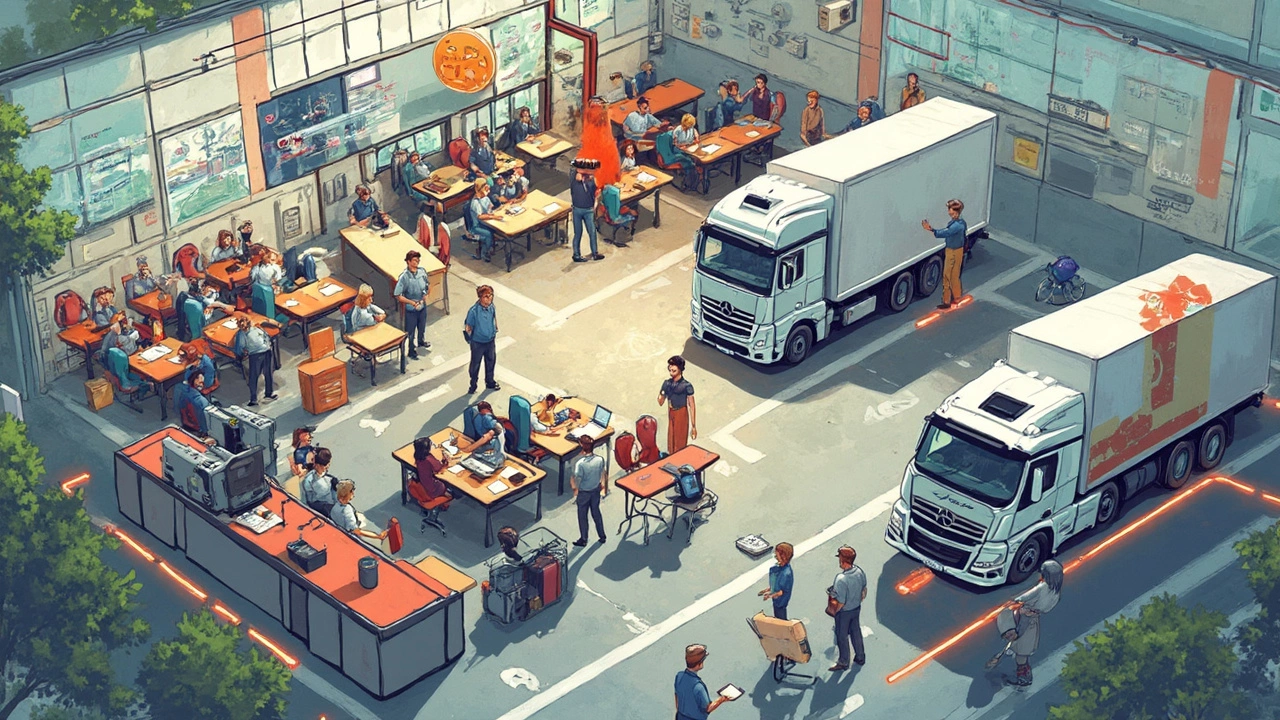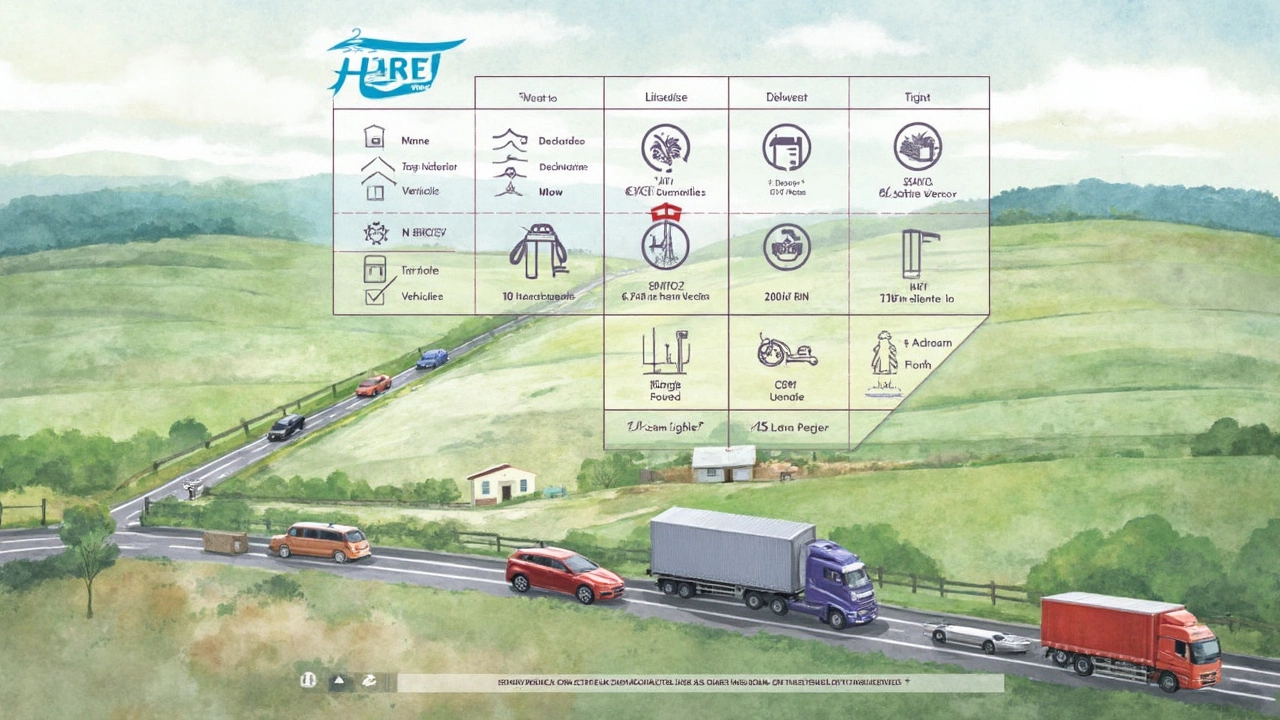So, you're sitting there wondering, "What's the real difference between an HGV and an LGV license?" You're not alone! It's one of those questions that floats around the world of driving licenses, probably because the terms get mixed up all the time. Let's break it down and get to the bottom of it.
First off, you'll often hear people talk about HGVs—Heavy Goods Vehicles—and LGVs—Large Goods Vehicles—as if they're totally different. Truth bomb: in the UK, they're basically used to mean the same thing. It can trip you up because in other places, LGV might mean Light Goods Vehicles, but not here. Tricky, right?
Now, whether you're aiming for an HGV or an LGV license, most of the core stuff you need to know applies to both. You’ve got to go through some proper training, and trust me, that’s not just hopping in the driver’s seat and crossing your fingers! You’ll have lessons, practical tests, and all sorts of things to tick off your list.
- The Meaning Behind HGV and LGV
- Licensing Requirements
- Training Tips and Resources
- Choosing the Right Path for You
- Navigating Career Opportunities
The Meaning Behind HGV and LGV
Alright, let's get into these acronyms that seem to cause so much confusion—HGV and LGV. You might've heard them thrown around almost interchangeably, which isn't surprising because in the UK, they often are! It’s all about the big vehicles used for transporting heavy and large loads.
So, what does each one mean? HGV stands for Heavy Goods Vehicle, and LGV stands for Large Goods Vehicle. In the UK, these terms refer to the same category of vehicle licenses. They might sound different, but they're actually covering the same bases for larger vehicles above 3.5 tonnes in weight. To put it simply, whether you’re talking about an HGV or an LGV license, you're dealing with similar criteria.
Now, here's where it can get tricky. Elsewhere in Europe, there's a twist—LGV might mean Light Goods Vehicle in some countries. For instance, in European parts like France, an LGV can refer to smaller, lighter vans. That can lead to a fair bit of confusion, especially if you speak with folks from outside the UK.
To wrap this up, if you’re in the UK and you're looking to drive a truck carrying more than 3.5 tonnes, the license you need falls into the same category whether you call it an HGV or an LGV license. It's like calling a couch a sofa—different names, same thing.
Understanding these distinctions is crucial for anyone considering a career in driving large vehicles. So if you're ever puzzled again, just remember: all those terms boil down to the same kind of license here in the UK!
Licensing Requirements
Alright, let's cut through the jargon and get right into it: what does it take to snag an HGV or LGV license in the UK? You can't just wake up one day and decide you're hitting the road with a massive truck. There's a process, and you'll need to follow it to the letter.
First thing's first—before you even think about getting behind the wheel, you need to be at least 18 years old. Once you check that box, you'll require a provisional lorry license. This is where the journey really starts. To apply for this, make sure you already have a full car driving license (Category B).
Here's a quick rundown of the steps:
- Medical Examination: Yep, you need to be medically fit. You'll have to pass a medical test, known as the D4 medical, which needs to be completed with a doctor.
- Theory Test: Just like you did for your car license, but this one's got a bit more to it. You'll take a theory test specific to HGV and LGV vehicles, which includes multiple-choice questions and a hazard perception test. Study up!
- Practical Training: Once you've passed the theory test, it’s time to get some hands-on experience. You'll undergo practical training with an approved instructor.
- Practical Driving Test: After your training, you'll take the practical driving test. This is where you prove you can handle big vehicles safely and confidently.
Here's an interesting tidbit: did you know that over 700,000 people hold an HGV license in the UK? That's a lot of people rolling across the nation's roads with giant vehicles!
Once you've got your license, it’s not set in stone forever. You’ll need to complete 35 hours of periodic training every five years to keep it valid. This keeps you up to speed with all the latest rules and regulations.
There you have it, your roadmap to earning your HGV or LGV license. Stick to it, and you'll be cruising in no time.

Training Tips and Resources
Alright, so you're set on diving into the world of HGV and LGV driving, but where do you start? There's a lot to learn, but don't sweat it, I've got some great tips to help you ace your training and get on the road.
First off, think about enrolling in a reputable driving school. This is key to getting quality training. Many driving schools offer specialized courses for HGV and LGV licenses, which focus on the practical and theoretical skills you need. Look for ones that are certified and have great reviews from past students.
"Choosing the right driving school can make all the difference. The instructors here taught me everything from gear shifts to loading safety," says Alex Johnson, an experienced HGV driver.
Hands-on practice is crucial. Once you're in the hot seat (literally and figuratively), you'll need to master vehicle control, learn how to maneuver that giant vehicle safely, and understand the ins and outs of the logistics. And don’t be shy to ask questions. The more you know, the more confidence you'll have.
It's also essential to familiarize yourself with the theoretical side. Invest time in understanding the Highway Code, load management, and safety regulations. Use resources like the official DVSA guides and practice mock theory tests online. They're gold, trust me.
- Join forums or online communities where seasoned drivers hang out. They’re goldmines of real-life tips and advice.
- Use apps or online platforms which help track your progress and keep your studying structured.
- Watch tutorials on YouTube - sometimes visualizing a tricky maneuver makes all the difference.
Lastly, make sure you’re physically and mentally prepared for those tests. It’s a big deal, so get plenty of rest, eat well, and find ways to manage stress. Some folks even find mindfulness exercises or basic workouts help keep them sharp and focused.
Choosing the Right Path for You
Alright, now that you know the basics, it’s time to figure out which license, HGV or LGV, suits your career goals. It might sound like a big decision, but breaking it down can make it a lot easier.
First, think about the kind of vehicles you want to drive. Are you dreaming of handling those massive trucks you see on the highway, or maybe something a bit smaller? In the UK, both HGV and LGV licenses cover similar categories, so it's really about the type of loads you want to move and the distance you're comfortable driving.
Look at job opportunities in your area. Some companies might specifically require an HGV license, especially if they're transporting heavier cargo across long distances. On the other hand, some local delivery services look for LGV-licensed drivers who can maneuver through city streets.
Another thing to consider is training availability. Not all training centers offer courses for both licenses, so check what's offered nearby. Good training is key to passing your tests and feeling confident on the road.
Lastly, think back on what’s most important to you in a job—like flexible hours, regional travel, or even the kind of salary you’re aiming for. Sometimes, talking to folks already in the industry can give you a real sense of what to expect.
Have a peek at available stats, and you might find that logistics is a booming biz right now. Here’s a quick snapshot to give you an idea of the typical salaries across regions:
| Region | Monthly Salary (GBP) |
|---|---|
| London | 2,800 - 3,200 |
| Midlands | 2,500 - 2,900 |
| Northern England | 2,400 - 2,700 |
| Scotland | 2,300 - 2,600 |
Bottom line? Weigh your goals against what each license offers. Whether you go with an HGV or LGV license, there’s a solid path for you in the world of driving. Happy deciding!

Navigating Career Opportunities
Once you've got your HGV or LGV license in hand, you're probably itching to hit the road and start earning. But where should you start? The world of heavy vehicles is full of opportunities these days, so let's map it out a bit.
First off, the biggest draw of getting these licenses is the flexibility and variety in job options. You could work for big haulage companies, doing long-distance driving across countries or you could opt for a local gig that brings you back home every evening. The choice is yours—and how great is that?
Ever think about how food gets to your supermarket, or how your online orders make it to your doorstep? HGV and LGV drivers play a massive role in pretty much everything that moves—from delivering groceries to carrying construction materials. Job benefits can range from great salaries to travel perks, and some companies even offer bonuses for night shifts or difficult routes.
If you're keen on a steady routine, supermarket chains and retail giants are often looking for reliable drivers. Alternatively, for those with an adventurous spirit, international haulage companies offer the chance to explore different places as you work.
LGV and HGV drivers are in demand across various industries, so knowing how to market yourself can help. Clean record, reliability, and perhaps a couple of niche skills, like handling hazardous materials, can put you a step ahead in getting jobs that might pay better.
The job market is always changing, but one thing's for sure: with an HGV or LGV license, you've got solid options. Whether you want job security or adventure on the road, you're in the driver's seat—literally!

